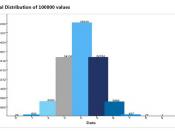Introduction
We learned more about ANOVA and Nonparametric tests after completing the simulation in week four. ANOVA assumes that each population being studied has a normal distribution, that errors are random and independent of each other, and that all the populations have the same variance. It is not always possible to make these assumptions and a nonparametric test, such as the Kruskal-Wallis can be used for analysis. Offering a summary of the simulation I am going to state what three lessons I learned relative to the ANOVA and Nonparametric tests, what analytic tools I will be able to use in my workplace, and what recommendations I would make to the decision maker about the situation in the simulation.
Lessons Learned
Being hired on as the Quality Assurance Manager for Praxidike Systems, it is my job to make sure delivery is on time and that the clients are satisfied. First I had to decide which type of test to use.
In order to be able to use ANOVA you have to make three major assumptions:
1.Errors are random and independent of each other.
2.Each population has normal distribution.
3.All populations have the same variance.
In order to check whether or not the population has a normal distribution, you need to use the chi-square test for goodness of fit. The hypotheses in this case are:
1.H0 The population has a normal distribution.
2.HA The population does not have a normal distribution.
The outcome was that the test statistic lies outside the acceptance area and you should reject the null hypothesis. As a result, you cannot presume that the population has a normal distribution; you should use the nonparametric Kruskal-Wallis test.
The second objective I learned was that you cannot always use the blocking technique. Blocking allows...


